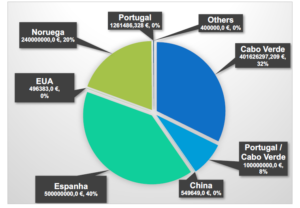Cape Verde consists of 10 main islands, which together with smaller islands occupy an area of 4,033 km2. The smallness and insular nature are typical for the country. Despite the absence of minerals and excessive drought, Cape Verde is known for its high economic growth and social development.

Population
There are currently 567,244 people living in Cape Verde. The majority is concentrated on Santiago Island (30, 6%), where the capital city of Praia is located. The only uninhabited island is Santa Luzia. Cape Verdean population is relatively young. More than 64 % of the population is under 34 years old. The average age is around 28 years. Due to strong and rapid urbanization, 67 % of Cape Verdeans live in the city which makes Cape Verde one of the countries with the highest proportion of the urban population in the world.
Population of Cape Verde
| Ostrov | Populace | % |
| Santo Antão | 37 658 | 6,8 |
| São Vicente | 84 964 | 15,3 |
| São Nicolau | 12 031 | 2,2 |
| Sal | 41 121 | 7,4 |
| Boa Vista | 19 879 | 3,6 |
| Maio | 7 525 | 1,4 |
| Santiago | 313 460 | 56,3 |
| Fogo | 34 815 | 6,3 |
| Brava | 5 405 | 1 |
The country respects human rights and guarantees the fundamental freedoms of the individual. According to foreign indexes, even Cape Verde is one of the most democratic countries in all of Africa and the 33rd most democratic country in the world.
The positive economic growth and democratic direction of the country also reflect in the indicators of social development. Cape Verde is one of the top in Africa in terms of access to education, health, electricity, the Internet, and drinking water. A total of 94.9 % of householders have access to drinking water and 91.4 % to electricity. The number of householders connected to the water supply and sewerage network is increasing every year.
The country has a quality infrastructure. There are 4 international airports in Cape Verde, 7 ports with sufficient capacity to receive long-distance vessels. Each of the islands has a thermoelectric power plant and desalination units. Wind and solar power plants on some islands can cover 20% of national consumption. Cape Verde also has a quality transport network.
Income variability in Cape Verde is relatively high, ranging from the minimum wage of € 122 to € 3 000 per month. The purchasing power of the population is generally lower. However, due to the wage disparity, approximately 15 % of the population has a relatively high purchasing power. There is a high demand for luxury goods in this part of the population. However, the Demand is also stimulated by tourists and Cape Verdean emigrants.
Economy
Cape Verdean economy is growing steadily. In the last 20 years, the value of GDP quadrupled due to the development of the service sector and foreign investment.

Tourism
Although Cape Verdean tourism can be considered as a relatively recent phenomenon, nowadays tourism accounts for a percentage of Cape Verdean GDP. The number of tourists visiting Cape Verde is growing every year. Until the start of the covid-19 pandemic, the average annual growth was 12%.

Investments
The volume of investments in Cape Verde is increasing almost every year. In 2020, according to Trade Invest, the value of approved investments in Cape Verde totaled 1 244 333 816 EUR and more than 12 000 jobs were created.

The main investment segments were tourism (80.2 %) and industry (19.3 %). New projects in the areas of transport, fishing, irrigation, and food production were financed in Cape Verde.

For the first time, the main beneficiaries are not the islands of Sal and Boavista, but Maio (40 %), Santiago (29 %), and Sao Vincente (20 %).

Most of them were foreign investments, especially from Spain (40 %), Norway (20 %), and Portugal (8 %). Cape Verdean investments accounted for 32 %.

Culture
Following the historical settlement and colonial dependence on Portugal in Cape Verce. The mixing of races in Cape Verde was constant. This created a completely unique cultural identity, which manifests itself in a number of areas.
Language is traditionally considered as the symbol of national identity. The Cape Verdean language Creole arose from the simplification of colonizing Portuguese. Although you rarely witness Creole in written form in the spoken form the Creole is very lively, dynamic, and rich. The Creole itself serves not only as an identifier of Cape Verdean nationality but also as a tool for spreading Cape Verdean culture in the diaspora.
Music has played an unquestionable role in the process of building Cape Verdean identity. It did not only spread Cape Verdean culture, but it also contributed to its diversity. Cape Verdean music is exceptional and includes many genres. Most popular of them are “morna”, “coladeira” and “funaná”. Nowadays you can hear Cape Verdean music performed by Cape Verdean singer Césarie Évora, also known as “Cisé” or “Diva dos Pés Descalcos”.
An often overlooked cultural element of the nation is its gastronomy. Cape Verdean cuisine distinguishes in preparation of the food itself and includes many rituals. The main ingredients are corn, beans, potatoes, and cassava. Lower food diversity associated with the lack of rainfall stimulated Cape Verdean creativity and generated rich gastronomy with unique dishes such as “Katxupa”, “xeren”, “cuscus”, “djagacida”, “pastéis”, “papa” and more. Noteworthy are also Cape Verdean sweets and liqueurs.
Cape Verde’s national identity is based on Christian values and morals. Christianity was imported to Cape Verde from the Portuguese dominion and closely connected Cape Verdean culture to the West-European culture. Nowadays, 93% of the population identifies themselves as Roman Catholics. However, all religious beliefs are respected. Religious disputes and riots are completely absent from the country.




